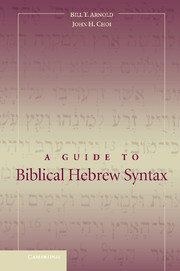2 - NOUNS
Published online by Cambridge University Press: 05 June 2012
Summary
By comparing evidence from early Semitic languages, scholars have concluded that pre-biblical Hebrew, and most likely all the Semitic languages of the second millennium b.c.e., had a declension system for the nouns (i.e., inflections), using cases parallel to those of Indo-European languages. Thus, endings were used to mark a subject case (the nominative, ending in singular -u, plural -ū, and dual -ā), an adjectival case, which was used also with all the prepositions (genitive in -i, -ī, and -ay), and an object case that also had many adverbial uses (accusative in -a, -ī, and -ay). However, the case endings were almost completely lost in all first-millennium Northwest Semitic languages, and they were certainly lost throughout all attested Hebrew.
Biblical Hebrew compensates for the lack of case endings through a variety of means, primarily word order (as in modern English) and syntactical relationships, as well as through the use of prepositions. So the nominative case is most frequently discerned by word order and the lack of other markers. The genitive is marked by the construct relationship (section 2.2), and the accusative primarily by the definite direct object marker תאֵ/ת־אֶ and other syntactical relationships (section 2.3). Although we are able to trace the history of the three case functions in ancient Hebrew by comparing other Semitic languages, some authorities believe we should abandon the traditional case terms (especially “nominative”) when describing BH syntax because the language does not mark the cases morphologically.
- Type
- Chapter
- Information
- A Guide to Biblical Hebrew Syntax , pp. 4 - 35Publisher: Cambridge University PressPrint publication year: 2003



